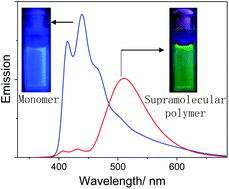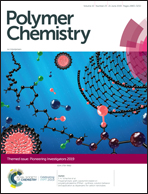Cooperative supramolecular polymerization of phosphorescent alkynyl-gold(i)–isocyanide complexes†
Abstract
In this work, coil–rod–coil organogold(I) complexes have been successfully assembled into phosphorescent supramolecular polymers via the cooperative nucleation–elongation mechanism. Deeper insights into the supramolecular polymerization behaviors are achieved via solvent-dependent UV-Vis and CD spectroscopic measurements. As compared to the structurally similar organoplatinum(II)-based systems, organogold(I) complexes display a stronger supramolecular polymerization tendency and higher resistance to solvent polarity change for the resulting assemblies. The phenomena are primarily ascribed to the low steric hindrance of the inner alkynyl-gold(I)–isocyanide rod unit.

- This article is part of the themed collection: Pioneering Investigators


 Please wait while we load your content...
Please wait while we load your content...